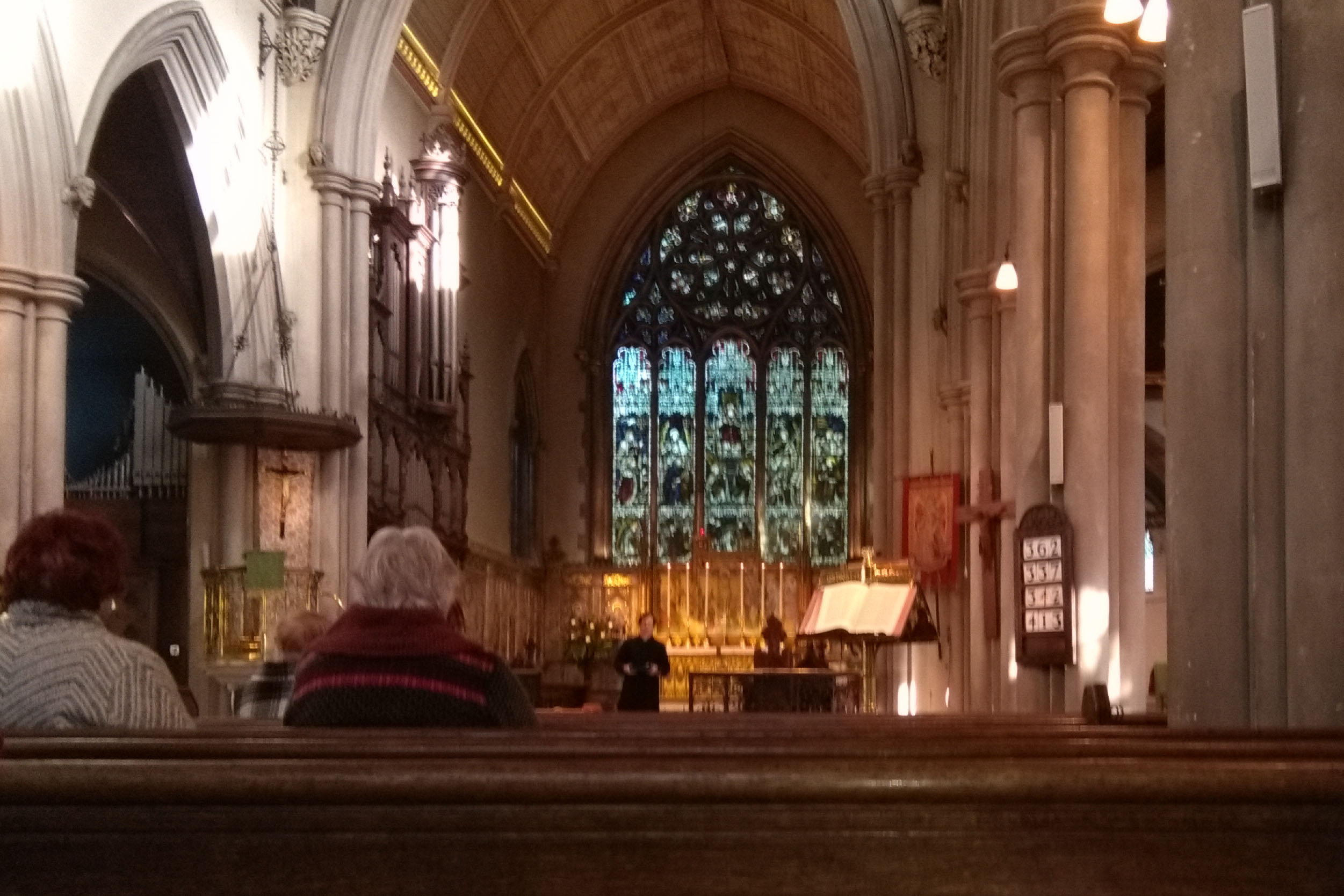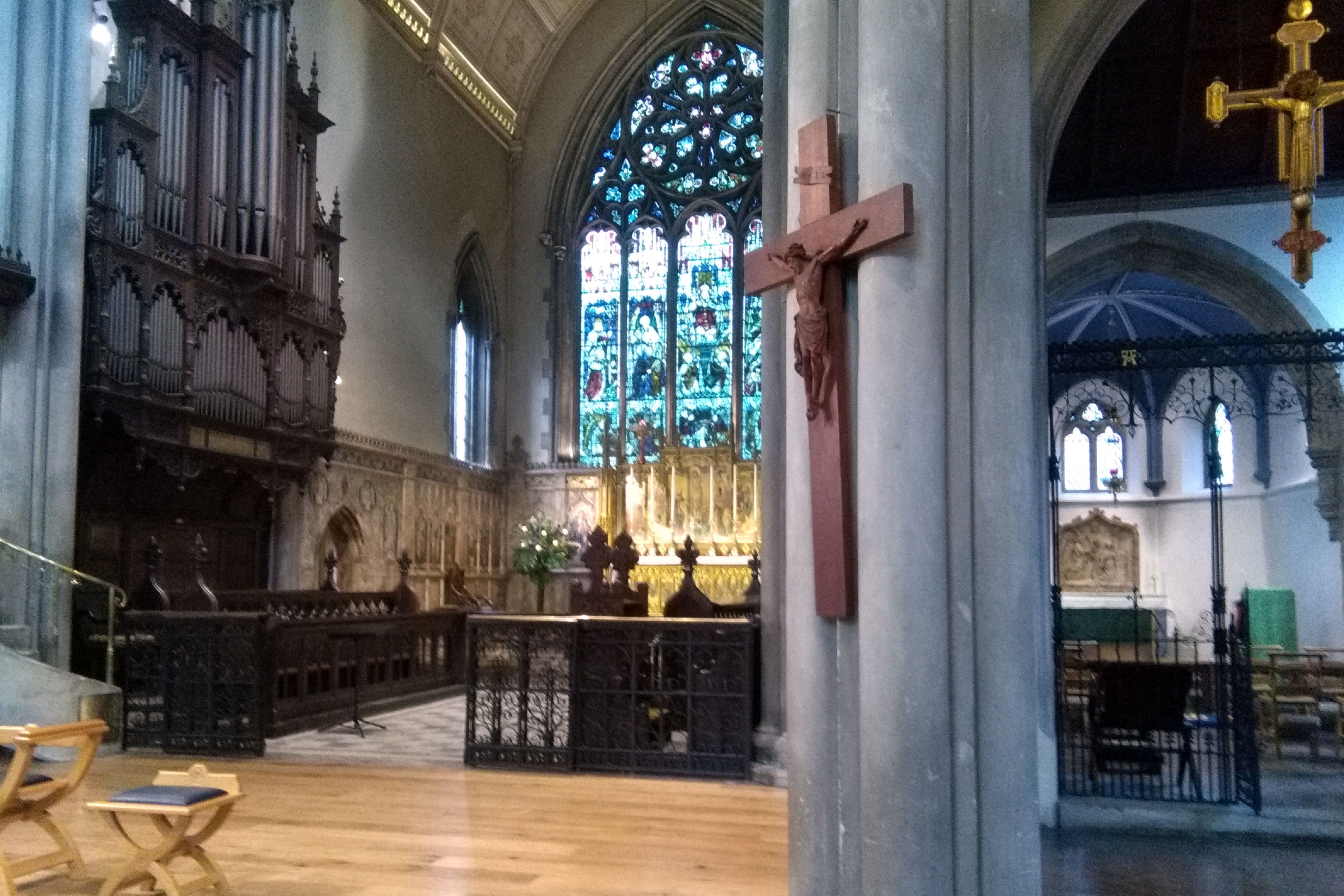| |
 |
 |
 |
| Comment on this report, or find other reports. |
 |
| Our Mystery Worshippers are volunteers who warm church pews for us around the world. If you'd like to become a Mystery Worshipper, start here. |
 |
| Find out how to reproduce this report in your church magazine or website. |
|
|
| 3251: St Gabrielís, Pimlico, London |
 |
 |
 |
Mystery Worshipper: Sipech.
The church: St Gabrielís, Pimlico, London.
Denomination: Church of England, Diocese of London.
The building: Built in the 1850s to a design by Thomas Cundy the Younger, who held the post of surveyor of the Grosvenor Estate during the development of the Belgravia and Pimlico districts of London by the 19th century master builder Thomas Cubitt. As you come in through the step-free entrance, the first thing to strike you is the ornateness of the interior. The chancel and high altar almost gleam back at you, while dotted around are some elaborate wood carvings. The east window, depicting Christ in Glory with Saints, was designed by the noted Victorian craftsman Charles Eamer Kempe.
The church: The parish was carved out of one of the wards of St Georgeís, Hanover Square. They typically hold four services on a Sunday and have other services on an almost daily basis throughout the rest of the week. St Gabrielís has adopted Resolutions A, B and C of the Church of England, rejecting the ordination of women, though they are not a member of the Church Society or Forward in Faith.
The neighbourhood: Pimlico is an affluent residential district on the north bank of the Thames, squeezed in between Westminster and Chelsea. It is largely built to the plans of Thomas Cubitt, a statue of whom is a few hundred yards from the church building. It was Cubittís idea that St Gabrielís form the central heart of the district. It is similar in appearance to nearby Belgravia, also designed by Cubitt, with long terraces of town houses, most of which have a striking white/cream colour and elaborate porches held up by small columns. The area is dotted by gardens, including Warwick Square, which sits next to the church, though these are inaccessible to members of the public. Upon wandering through the neighbourhood, one notices that many of these houses have been converted into hotels and guest houses.
The cast: The service was led by the vicar, the Revd Owen Higgs. He was assisted by three acolytes.
The date & time: Thirty-First Sunday in Ordinary Time, 5 November 2017, 10.30am.
What was the name of the service?
Sung Mass.
How full was the building?
It was a little under half full, with about 60 people in total. There was a reasonable mix of ages, though for a London congregation it was unusual not to see more BAME (black, Asian, minority ethnic – that is to say, non-white) people.
Did anyone welcome you personally?
I was handed a hymn book by someone who greeted me by commenting on how cold it was outside. I took a seat, but no one else said hello.
Was your pew comfortable?
A fairly standard wooden pew with some kneelers in front. There was no other cushioning, so it was tolerable, but not comfortable. The pews werenít spaced very far apart, which made kneeling an issue. Given they had relatively high backs, the shorter worshipper would find his chin resting on the back of the pew in front.
How would you describe the pre-service
atmosphere?
Nobody really spoke to one another. Everyone sat facing the front of the church while the organist played.
What were the exact opening words of the
service?
"In the name of the Father, and of the Son, and of the Holy Spirit."
What books did the congregation use during the
service?
We sang from the New English Hymnal, which looked more well-used than new. Inside was tucked a notice sheet that had the order of service on it. There was also a booklet containing the liturgy, which was taken from Common Worship Order 1 in contemporary language. Readings were taken from the Jerusalem Bible. At times it was hard to know which book to follow, which resulted in a certain amount of fumbling on my part.
What musical instruments were played?
There was an organ, which was very well played. It was originally built in 1925 by James Jepson Binns of Leeds, but was rebuilt by JW Walker & Sons in 1970. The sung worship was led by a seven piece choir, though I gather many of them were visiting, as many of the regular choir were away for a wedding of one of the sopranos.
Did anything distract you?
During communion, as most people filed forward, the chap on the end of my pew didnít move. Given the narrow spacing, it would have been very difficult to squeeze past him. So I sat for a panicked couple of minutes thinking I would unable to partake of the eucharist. Eventually, though, I went out of the wrong side of the pew and had to walk half way round the back of the church to join the queue.

Was the worship stiff-upper-lip, happy clappy, or
what?
This was about as high church as you get in the C of E. Smells and bells aplenty and with no fewer than four Hail Marys. Many of the refrains were done with a kind of sing-speaking. The vicar wore a green and gold chasuble over his cassock, while the acolytes all wore surplices over theirs. At the institution of the eucharist, the vicar remained eastward-facing, his back turned towards the congregation.
Exactly how long was the sermon?
12 minutes.
On a scale of 1-10, how good was the preacher?
6 – Father Owen spoke with an ostensibly posh voice from the top of an elevated pulpit. It felt like he was trying hard to imbue his voice was gravitas, possibly as a way to disguise his slight lisp.
In a nutshell, what was the sermon
about?
Using Matthew 23:1-12 (do as the scribes and Pharisees say, not as they do) as the base text, it was about not misappropriating the titles that belong to God. The prohibition in verse 9 of calling anyone "father" was (most scholars believe, so said Father Owen) probably tacked on by Matthew and never actually spoken by Jesus (although the scholars appealed to were never named). Martin Luther said that the Pharisees were evil but that the Pope was 100 times worse. Thankfully weíve moved on since then, and our understanding of the Bible has progressed since Luther, though such understanding still owes a great deal to the way he paved for us. The call to disavow the use of titles such as rabbi, father or teacher was done as a means of encouraging humility. For while the Church is called to have leaders, they are radically equal to all others in the Church. But misuses of power do occur: in parochial church councils, choirs, and among vicars, to say nothing of recent revelations concerning Hollywood and Parliament. To shun the trappings of power we must remain humble; the best ways to do this are to remember that we all sinners and to keep in mind the person and work of Jesus Christ.
Which part of the service was like being in
heaven?
The scripture readings were very well done. In particular, there was a passage from Malachi that was read by an older gentleman whose mellifluous tones were a pleasure to listen to. He brought life into the passage, with good use of cadence. Such was his mastery of the spoken word, I might suspect he had a theatrical background.
And which part was like being in... er... the other place?
I was going to say having my way to communion being blocked, but this was eclipsed by what happened as the service ended (see below).
What happened when you hung around after the service looking lost?
I handed back my hymn book and somebody asked if I wanted coffee. So I went over and joined the queue. No sooner had I done so when several others queue-jumped in front of me. When I eventually got to the front, somebody placed the last mug in front of me, but then a chap barged in and took it before I had a chance to pick it up. So I turned around and had a little wander around the church before heading out.
How would you describe the after-service
coffee?
I canít say as I wasnít able to sample it.
How would you feel about making this church your regular (where 10 = ecstatic, 0 = terminal)?
4 – I wasnít made to feel particularly welcome, so would have no itching desire to return.
Did the service make you feel glad to be a
Christian?
Not especially.

What one thing will you remember about all this in seven days' time?
The very poor manners of the parishioners. |
|
|
 |
 |
 |
| We rely on voluntary donations to stay online. If you're a regular visitor to Ship of Fools, please consider supporting us. |
 |
 |
 |
| The Mystery Pilgrim |
 |
| One of our most seasoned reporters makes the Camino pilgrimage to Santiago de Compostela in Spain. Read here. |
 |
 |
 |
| London churches |
 |
| Read reports from 70 London churches, visited by a small army of Mystery Worshippers on one single Sunday. Read here. |
| |
|
|
|
|


